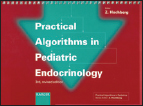Translate this page into:
Practical Algorithms in Paediatric Endocrinology
Corresponding Author:
Vijayalakshmi Bhatia
Department of Endocrinology, Sanjay Gandhi Postgraduate Institute of Medical Sciences, Lucknow, Uttar Pradesh
India
vbhatia@sgpgi.ac.in
| How to cite this article: Gupta S, Bhatia V. Practical Algorithms in Paediatric Endocrinology. Natl Med J India 2018;31:314-315 |
Practical Algorithms in Paediatric Endocrinology. Z. Hochberg. Karger, Basel 2017. 113pp, price not mentioned. ISBN 978-3-318-05917-5.

This is the third edition of the endocrine volume of the Karger’s series of practical algorithms in paediatrics. As the name suggests, the book provides algorithms for the approach, diagnosis and treatment of almost all the commonly encountered endocrine and metabolic abnormalities and emergencies. The editor and contributors are all stalwarts and the most respected names in paediatric endocrinology and diabetes. The flowcharts are clear and easy to follow, and help in simplifying the complex problems of endocrinology. For explaining the pathophysiology that forms the basis of a particular action and the details regarding the diagnostic tests used, each algorithm is accompanied by a facing page of ‘comments’, which is useful and adds to the overall understanding about the disease. Since the last edition, which was published 9 years back, keeping pace with the advent of new scientific findings especially in molecular sciences, the authors have thoroughly revised and updated the flowcharts particularly pertaining to growth and disorders of sex development and have added the OMIM (Online Mendelian Inheritance in Men) number to various genetic conditions. Two new flowcharts on Klinefelter syndrome and neonatal hypocalcaemia have been added. Although most of the flowcharts are comprehensive, a few algorithms, such as those pertaining to electrolyte imbalance, could have been made in more detail. The overall content is well organized and up- to-date.
The book will be useful for paediatricians and general physicians who are relatively less experienced in dealing with endocrine disorders, providing a practical approach for the workup and management of common endocrine cases and emergencies. Students of paediatric and adult endocrinology will also find this book useful in their day-to-day practice. It would also be useful for emergency department and intensive care specialists; gynaecologists, paediatric surgeons and paediatric urologists would find some chapters useful. However, where an understanding of complex topics is concerned, this book cannot take the place of a textbook. For the readers, who are interested in further details, a list of carefully selected 3-6 recent articles is given at the end.
The book is attractive with the unconventional spiral binding in the landscape format, although some would prefer the portrait one. The book is slim and easy to carry around; a slightly bigger font of printing would have made it a bit easy to read. All in all, we would highly recommend this book.
Fulltext Views
2,288
PDF downloads
1,306




